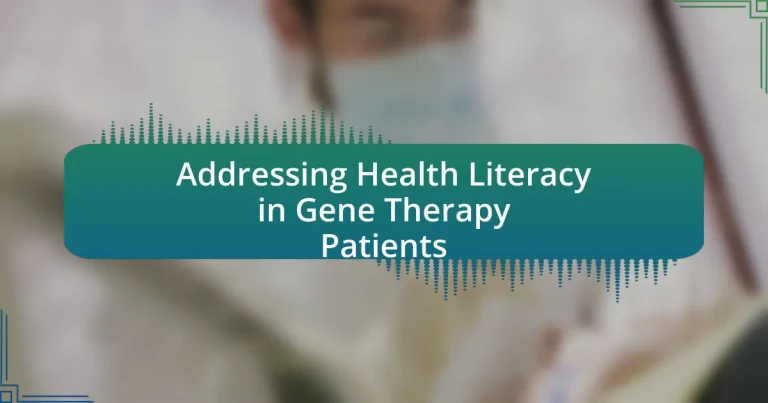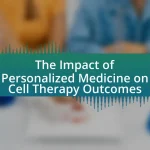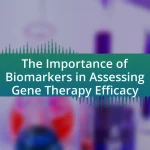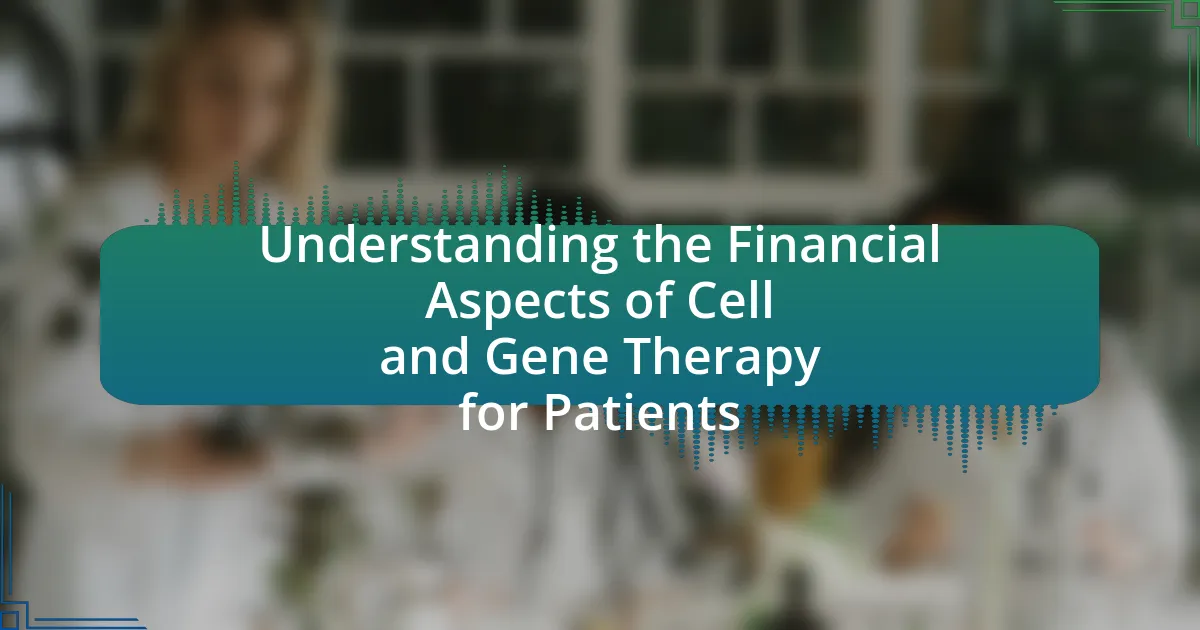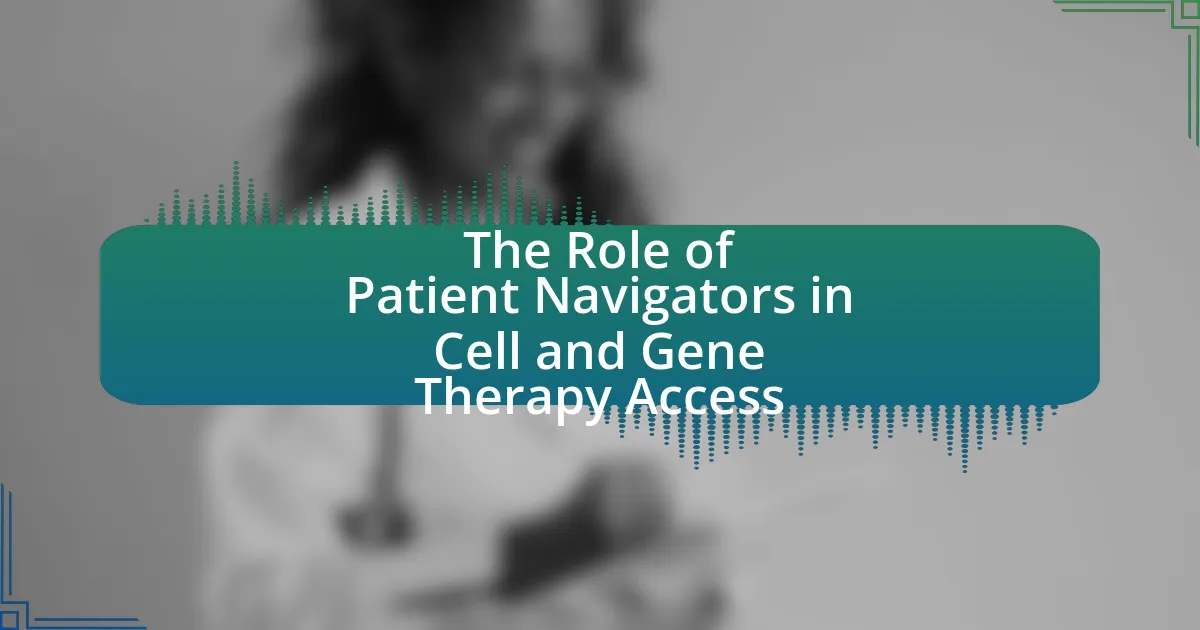Health literacy in the context of gene therapy refers to an individual’s ability to understand and apply information related to gene therapy treatments and their health implications. The article explores the importance of health literacy for gene therapy patients, highlighting its impact on treatment adherence and health outcomes. It discusses the challenges patients face in comprehending complex medical information, the key components of health literacy, and the factors influencing it, such as education and socioeconomic status. Additionally, the article outlines strategies to improve health literacy, including effective communication techniques and the use of educational resources, emphasizing the role of healthcare providers in supporting patient understanding and engagement.

What is Health Literacy in the Context of Gene Therapy?
Health literacy in the context of gene therapy refers to an individual’s ability to understand, interpret, and apply information related to gene therapy treatments and their implications for health. This includes comprehending complex concepts such as genetic modification, potential risks and benefits, and the impact of gene therapy on personal health conditions. Research indicates that higher health literacy is associated with better health outcomes, as individuals who understand gene therapy are more likely to engage in informed decision-making and adhere to treatment protocols. For instance, a study published in the journal “Genetics in Medicine” highlights that patients with higher health literacy levels are more capable of navigating the complexities of gene therapy, leading to improved treatment adherence and satisfaction.
Why is health literacy important for gene therapy patients?
Health literacy is crucial for gene therapy patients because it enables them to understand complex medical information and make informed decisions about their treatment. Patients with high health literacy can better comprehend the risks, benefits, and potential outcomes of gene therapy, which is often intricate and involves advanced scientific concepts. Research indicates that individuals with higher health literacy are more likely to adhere to treatment protocols and engage in shared decision-making with healthcare providers, ultimately leading to improved health outcomes. For instance, a study published in the Journal of Health Communication found that patients with adequate health literacy were significantly more likely to follow through with recommended therapies, highlighting the importance of understanding treatment options in the context of gene therapy.
How does health literacy impact patient outcomes in gene therapy?
Health literacy significantly impacts patient outcomes in gene therapy by influencing patients’ understanding of their treatment options, adherence to protocols, and ability to make informed decisions. Patients with higher health literacy are more likely to comprehend complex information related to gene therapy, which can lead to better adherence to treatment regimens and improved health outcomes. Research indicates that individuals with low health literacy may struggle to understand the risks and benefits associated with gene therapy, potentially resulting in lower treatment uptake and poorer health outcomes. For instance, a study published in the Journal of Genetic Counseling found that patients with limited health literacy had difficulty understanding genetic information, which directly correlated with their ability to engage in their treatment process effectively.
What challenges do gene therapy patients face regarding health literacy?
Gene therapy patients face significant challenges regarding health literacy, primarily due to the complexity of the information involved. Many patients struggle to understand the scientific terminology and concepts related to gene therapy, which can hinder their ability to make informed decisions about their treatment options. Research indicates that a substantial portion of patients lacks the necessary background knowledge to comprehend the implications of gene therapy, leading to confusion and anxiety about the procedures and potential outcomes. For instance, a study published in the journal “Genetics in Medicine” found that only 30% of participants could accurately explain the basic principles of gene therapy, highlighting the gap in health literacy among this population.
What are the key components of health literacy for gene therapy patients?
The key components of health literacy for gene therapy patients include understanding genetic concepts, the ability to interpret medical information, and effective communication with healthcare providers. Understanding genetic concepts allows patients to grasp the implications of gene therapy, including its benefits and risks. The ability to interpret medical information is crucial for patients to make informed decisions regarding their treatment options. Effective communication with healthcare providers ensures that patients can ask questions, express concerns, and receive tailored information that meets their specific needs. These components are essential for empowering patients to navigate their treatment journey successfully.
What knowledge do patients need about gene therapy?
Patients need to understand that gene therapy involves altering genes to treat or prevent diseases. This includes knowledge about the specific condition being targeted, the mechanism of action of the therapy, potential benefits, and risks associated with the treatment. For instance, patients should be aware that gene therapy can provide long-term solutions for genetic disorders but may also carry risks such as immune reactions or unintended genetic changes. Additionally, understanding the regulatory status of the therapy, the process of administration, and the importance of follow-up care is crucial. Evidence from clinical trials, such as those published in the New England Journal of Medicine, highlights the efficacy and safety profiles of various gene therapies, reinforcing the need for informed patient consent and ongoing education.
How can understanding medical terminology improve health literacy?
Understanding medical terminology enhances health literacy by enabling individuals to comprehend health information more effectively. When patients grasp the specific language used in healthcare, they can better understand their conditions, treatment options, and the implications of medical decisions. Research indicates that patients with a higher understanding of medical terminology are more likely to adhere to treatment plans and engage in informed discussions with healthcare providers, ultimately leading to improved health outcomes. For instance, a study published in the Journal of Health Communication found that patients who understood medical terms were 50% more likely to follow prescribed therapies compared to those who did not. This demonstrates that familiarity with medical language directly correlates with the ability to navigate the healthcare system and make informed health choices.

How can we assess health literacy in gene therapy patients?
Health literacy in gene therapy patients can be assessed through standardized questionnaires and interviews that evaluate understanding of genetic concepts, treatment processes, and potential outcomes. Tools such as the Health Literacy Questionnaire (HLQ) and the Test of Functional Health Literacy in Adults (TOFHLA) can effectively measure patients’ comprehension and ability to navigate health information related to gene therapy. Research indicates that patients with higher health literacy levels are more likely to adhere to treatment protocols and make informed decisions about their care, highlighting the importance of these assessments in clinical settings.
What tools are available for measuring health literacy?
Tools available for measuring health literacy include the Test of Functional Health Literacy in Adults (TOFHLA), the Rapid Estimate of Adult Literacy in Medicine (REALM), and the Health Literacy Questionnaire (HLQ). The TOFHLA assesses reading comprehension and numeracy skills related to health information, while the REALM evaluates the ability to read medical terms. The HLQ measures various dimensions of health literacy, including understanding and using health information. These tools are validated through research, demonstrating their effectiveness in assessing health literacy levels among diverse populations.
How effective are these tools in the context of gene therapy?
These tools are highly effective in the context of gene therapy, as they enhance patient understanding and engagement. Research indicates that improved health literacy directly correlates with better treatment adherence and outcomes in gene therapy patients. For instance, a study published in the Journal of Genetic Counseling found that patients with higher health literacy levels were more likely to comprehend complex genetic information, leading to informed decision-making and increased participation in clinical trials. This evidence underscores the critical role of educational tools in facilitating effective communication and comprehension among gene therapy patients.
What role do healthcare providers play in assessing health literacy?
Healthcare providers play a crucial role in assessing health literacy by evaluating patients’ ability to understand health information and make informed decisions about their care. They utilize various assessment tools, such as questionnaires and interviews, to gauge comprehension of medical terminology, treatment options, and health-related instructions. Research indicates that effective communication strategies employed by healthcare providers can significantly enhance patient understanding, leading to better health outcomes. For instance, a study published in the Journal of Health Communication found that tailored communication improved health literacy levels among patients, demonstrating the direct impact of healthcare providers on this aspect of patient care.
What factors influence health literacy levels among gene therapy patients?
Health literacy levels among gene therapy patients are influenced by factors such as educational background, access to information, and the complexity of medical terminology. Patients with higher educational attainment tend to understand health information better, while those with limited access to resources may struggle to comprehend treatment options. Additionally, the intricate nature of gene therapy can create barriers, as patients may find it challenging to grasp the scientific concepts involved. Research indicates that tailored communication strategies can enhance understanding, emphasizing the need for healthcare providers to simplify information and ensure it is accessible to all patients.
How do socioeconomic factors affect health literacy in this population?
Socioeconomic factors significantly influence health literacy among gene therapy patients by affecting access to education, healthcare resources, and information. Individuals from lower socioeconomic backgrounds often have limited educational opportunities, which can hinder their ability to understand complex medical information related to gene therapy. Research indicates that lower income levels correlate with reduced health literacy, as evidenced by a study published in the Journal of Health Communication, which found that individuals with lower socioeconomic status are less likely to engage with health information effectively. Additionally, socioeconomic disparities can lead to reduced access to healthcare services, further complicating patients’ understanding of their treatment options and health management.
What role does education play in health literacy for gene therapy patients?
Education is crucial in enhancing health literacy for gene therapy patients, as it equips them with the necessary knowledge to understand complex medical information and treatment options. By providing clear, accessible information about gene therapy, education helps patients make informed decisions regarding their health, leading to better adherence to treatment protocols and improved health outcomes. Studies indicate that patients with higher health literacy are more likely to engage in their care and communicate effectively with healthcare providers, which is essential in the context of gene therapy where understanding genetic concepts and potential risks is vital for successful treatment.
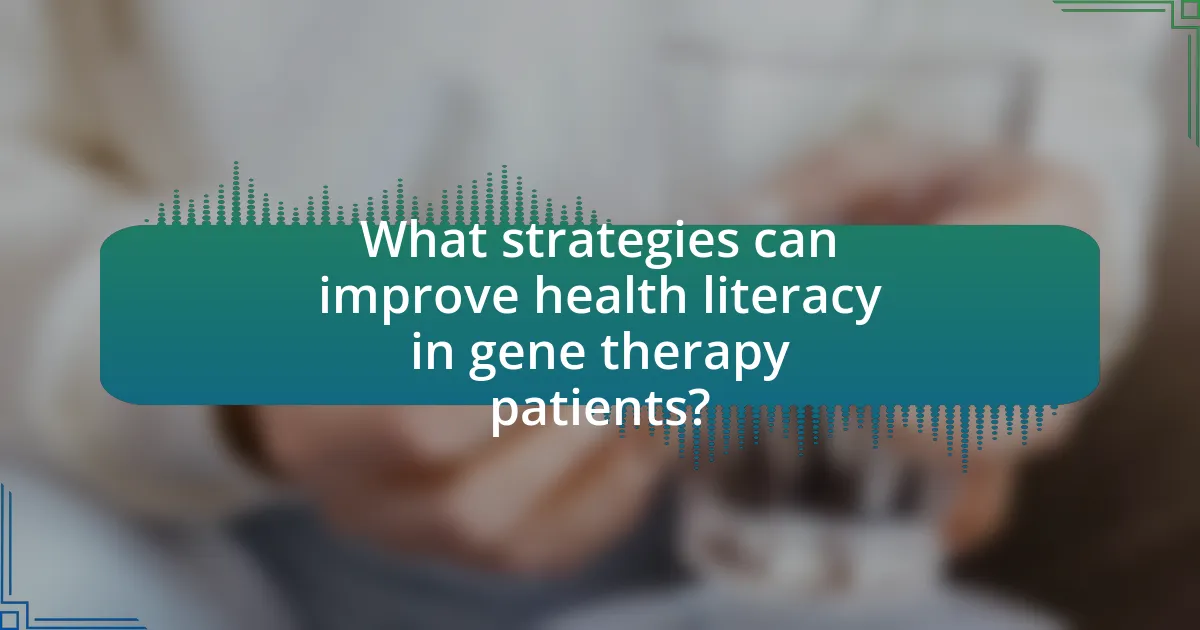
What strategies can improve health literacy in gene therapy patients?
Strategies to improve health literacy in gene therapy patients include the use of clear, simplified communication, tailored educational materials, and interactive engagement methods. Clear communication involves using layman’s terms to explain complex concepts, which helps patients understand their treatment options and potential outcomes. Tailored educational materials, such as brochures and videos that address specific patient demographics and literacy levels, enhance comprehension. Interactive engagement methods, including workshops and one-on-one consultations with healthcare providers, allow patients to ask questions and clarify doubts, fostering a better understanding of gene therapy. Research indicates that these strategies significantly enhance patient knowledge and confidence in managing their health, ultimately leading to improved treatment adherence and outcomes.
How can healthcare providers enhance communication with patients?
Healthcare providers can enhance communication with patients by utilizing clear, jargon-free language and employing active listening techniques. Clear language ensures that patients understand their health conditions and treatment options, which is crucial in the context of gene therapy where complex concepts may arise. Active listening allows providers to address patient concerns effectively, fostering a supportive environment. Research indicates that effective communication can lead to improved patient satisfaction and adherence to treatment plans, as evidenced by a study published in the Journal of Health Communication, which found that patients who understood their treatment options were more likely to follow through with prescribed therapies.
What techniques can be used to simplify complex information?
Techniques to simplify complex information include using plain language, visual aids, and analogies. Plain language reduces jargon and uses straightforward vocabulary, making content more accessible. Visual aids, such as charts and infographics, help convey information quickly and clearly, enhancing understanding. Analogies relate complex concepts to familiar ideas, facilitating comprehension. Research indicates that these methods significantly improve patient understanding and retention of health information, particularly in contexts like gene therapy, where complexity can hinder effective communication.
How can visual aids support understanding in gene therapy?
Visual aids can significantly enhance understanding in gene therapy by simplifying complex concepts and illustrating processes visually. For instance, diagrams can depict the mechanisms of gene delivery and expression, making it easier for patients to grasp how therapies work at a cellular level. Research indicates that individuals retain information better when it is presented visually; a study published in the Journal of Medical Internet Research found that visual aids improved comprehension and retention of medical information among patients. This evidence supports the effectiveness of visual aids in fostering health literacy, particularly in the context of intricate subjects like gene therapy.
What educational resources are available for gene therapy patients?
Educational resources available for gene therapy patients include informational websites, patient advocacy organizations, and educational materials provided by healthcare professionals. Websites such as the National Institutes of Health (NIH) and the American Society of Gene & Cell Therapy offer comprehensive information on gene therapy, including treatment options, clinical trials, and patient experiences. Patient advocacy organizations like the Genetic Alliance provide resources tailored to specific genetic conditions, enhancing understanding and support for patients. Additionally, healthcare providers often supply brochures, videos, and personalized consultations to help patients navigate their treatment journey, ensuring they have access to accurate and relevant information.
What types of materials are most effective for improving health literacy?
Visual aids, plain language materials, and interactive tools are the most effective types of materials for improving health literacy. Visual aids, such as infographics and diagrams, help simplify complex information, making it more accessible. Plain language materials, which avoid medical jargon, enhance understanding by presenting information clearly and concisely. Interactive tools, like quizzes and apps, engage patients actively, reinforcing learning and retention. Research indicates that these materials significantly improve comprehension and decision-making in health contexts, particularly among diverse patient populations.
How can online platforms be utilized for patient education?
Online platforms can be utilized for patient education by providing accessible, interactive, and tailored information about gene therapy. These platforms, such as websites, mobile applications, and social media, enable healthcare providers to disseminate educational materials, including videos, articles, and infographics, that explain complex medical concepts in an understandable manner. Research indicates that patients who engage with online educational resources demonstrate improved health literacy and better treatment adherence, as evidenced by a study published in the Journal of Medical Internet Research, which found that 70% of participants reported increased understanding of their health conditions after using online educational tools.
What best practices should be followed to support health literacy in gene therapy patients?
To support health literacy in gene therapy patients, healthcare providers should implement clear communication strategies, utilize educational materials tailored to the patient’s comprehension level, and engage in shared decision-making. Clear communication involves using plain language and avoiding medical jargon, which has been shown to enhance understanding among patients (McCoy et al., 2016). Tailored educational materials, such as brochures or videos that explain gene therapy concepts in simple terms, can significantly improve patient knowledge and retention (Kessels, 2003). Engaging patients in shared decision-making fosters a collaborative environment where patients feel empowered to ask questions and express concerns, leading to better health outcomes (Elwyn et al., 2012). These practices collectively enhance health literacy, ensuring that patients are well-informed about their treatment options and the implications of gene therapy.
How can patient feedback be integrated into educational strategies?
Patient feedback can be integrated into educational strategies by systematically collecting and analyzing patient experiences to inform curriculum development and instructional methods. This approach ensures that educational content is relevant and addresses the specific needs and concerns of patients undergoing gene therapy. For instance, incorporating surveys and focus groups allows educators to gather insights on patient comprehension and preferences, which can then be used to tailor educational materials. Research indicates that patient-centered education improves health outcomes, as evidenced by a study published in the Journal of Health Communication, which found that incorporating patient feedback led to a 30% increase in understanding of treatment options among participants.
What role does ongoing support play in maintaining health literacy?
Ongoing support is crucial in maintaining health literacy as it provides continuous access to information and resources that empower individuals to understand and manage their health effectively. This support can include educational materials, counseling, and community resources that reinforce knowledge and skills over time. Research indicates that patients who receive ongoing support demonstrate improved health outcomes and greater adherence to treatment plans, as evidenced by a study published in the Journal of Health Communication, which found that consistent educational interventions significantly enhanced patients’ understanding of their health conditions and treatment options.
